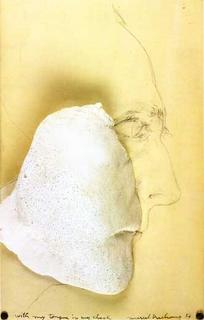
Often during the piece of the week entries to this blog the phrase tongue in cheek pops up. For example Engine Trouble was “a short one minute piece celebrating (if somewhat tongue in cheek) the pleasures of motorbikin.”
But tongue in cheek suggests what; a lack of seriousness, a gentle bit of fun, a certain irony or perhaps a pastiche? All of these descriptions sound somewhat dismissive as if to be ‘tongue in cheek” was amusing but perhaps little more. However such dismissiveness is far from what is intended, indeed I would argue that tongue in cheek thinking is central to a reflexive post modernist art practice.
Key to this is pastiche. Pastiche has rather a bad press recently; it is often used in a derogatory sense. Thus much of the architecture championed by Prince Charles is described by architecture journals as “merely a pastiche of Victorian/ classical architecture”. In other words it’s a fake, a phoney lacking integrity and substance. I wouldn’t disagree with this assessment but I would disagree with the use of the word pastiche.
The word pastiche originally implied a certain transvestisism; it was a knowing imitation of another, imitating, but respectful to the original. In the Late 19th century it began to acquire a second meaning, which implies less of a careful studied understanding and more of a mannered copying. A pastiche then became a msih mash of styles, a hodge podge. As such pastiche became in certain quarters a term of abuse. The original meaning remained but was increasingly threatened by the second.
High Modernism of course disliked the whole idea of pastiche; the Greenbergian emphasis on the integrity of material saw pastiche as too lightweight, fey and threatening. Post modernism arguably embraced pastiche as a key way of displacing the integrity of authorship and of undermining the original in favour of the metatext full of quotes and nods and winks to this and that. However the plunderphonic approach has become somewhat stale of late and artistically and philosophically there has been something of a yearning for a return to the certainties of value if not to the actual establishment values of yesteryear.
This manifests itself in a number of ways. For example on the Momus blog recently there was a heated debate about a new Resonance radio show by Rhodri. The crux of Momus’s gripe with Rhodri seemed to be that he was proposing a show that embraced mainstream music such as Toto and that under the guise of irony the show was acting as a Trojan horse for the dilution of the core avant garde values of Resonance. Rhodri for his part argued that his liking of Toto was not ironic, this was not a case he said of its so bad its good. Rhodri said he genuinely liked Toto and the Doobie Brothers just as he liked more left field music such as Momus.
The positions adopted by Momus and Rhodri can be seen as very similar manifestations of late postmodernism. In Momus’s case we have a desire for a return to the integrity of avant garde, complete with a dislike for the perceived Trojan horse of irony and pastiche in Rhodri’s case there is a similar dismissal of irony but on the grounds that there is no division between the values of the mainstream and the avant garde, no high or low brow, its all just music. Both approaches of are in their way misguided and misunderstand the importance of pastiche.
Pastiche if used correctly can be a reflexive tool; it allows the wearing of the clothes of the other whilst retaining a distance. Pastiche admits an attraction for the form and nuances of what is being “covered” but without succumbing to it.It’s a tricky balance; get too close and you slip from pastiche into mimicry and then from mimicry into actually adopting the style of the other.
Pastiche is not kitsch, it can be applied to both to the popular and to the materialist. It is not an excuse for anything goes mix and match. Duchamp the arch practitioner of pastiche is often accused of ushering in a phase of simple reconctextualisation in fine art but Duchamp always kept his distance; carefully limiting the numbers of ready-mades aware of how seductive they could be.
It is perhaps only by accepting that romantic seduction is part of the creative process that it can be held in check. To deny it as modernism and materialism so often does it be left will almost nothing but process, to give in it to is also a dead-end of sentimental abandon.
No comments:
Post a Comment